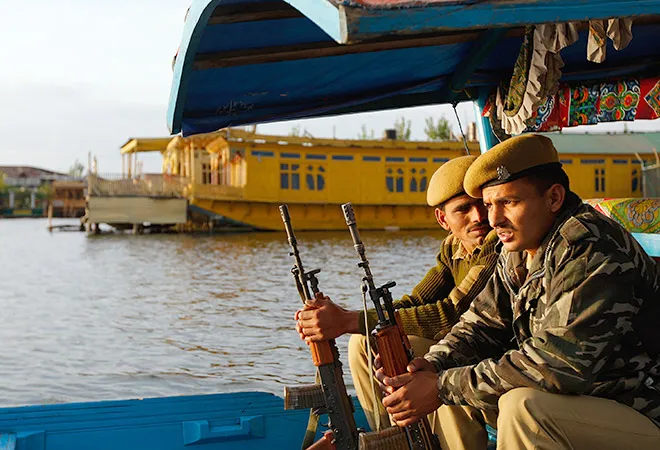
The encounter killing of Lateef Dar in Shopian on 3 May 2019 marked the elimination of the Burhan gang. However, the 11 Kashmiri boys that formed the gang — assuming a heroic status — after their photograph, dressed in military fatigues and wielding Kalashnikov rifles, went viral — have largely changed the nature of terror in the Kashmir Valley. All of this, has happened within a short period of just four years.
First published in June 2015, the photograph of the Burhan gang emerged as a symbol of Kashmir’s ‘struggle’ against the Indian state. It gave rise to a debate on the increasing willingness of the Kashmiri youth in embracing a gun culture. While their parent organisation (tanzeem) Hizbul Mujahideen (HM) has been at the centre of terrorism in Kashmir for nearly three decades, the Burhan gang, in particular, came into limelight after Burhan Wani was gunned down in July 2016.
First published in June 2015, the photograph of the Burhan gang emerged as a symbol of Kashmir’s ‘struggle’ against the Indian state. It gave rise to a debate on the increasing willingness of the Kashmiri youth in embracing a gun culture.
The gang may have been eliminated, but it was successful in sowing the seeds for a methodical progression of terrorism in the Kashmir Valley.
First, the Burhan gang made terrorism in the Valley social media-driven. Popularity of terrorists like Burhan Wani can be credited to social media campaigns, run by the group and their individual followers. Social media platforms, which have eased communication and given a voice to the unheard, have been weaponised by the tanzeems in Kashmir.
The Burhan gang made terrorism in the Valley social media-driven. Popularity of terrorists like Burhan Wani can be credited to social media campaigns, run by the group and their individual followers.
Tanzeems have established a new demography of protestors and extremists. Every individual has become his own broadcaster of information, photographs and videos — resulting in the creation of a domino effect. No leader is required to run information campaigns. People exchange ideas and act on them.
Constant hate propaganda has streamlined the process of radicalisation, recruitment, declaration of new terrorists and publicity of their ‘martyrdom’. Anti-India propaganda has been made to appear legitimate as new recruits are projected to be victims of the State as well as Kashmir’s saviours. ‘Terror masters’ have resorted to the digital media as it gives them the necessary cover, space, speed as well convenience of influencing the youth. In Kashmir, social media strategies have morphed into a tradition where false narratives create heroes out of fallen terrorists and radicalised new recruits as icons.
Constant hate propaganda has streamlined the process of radicalisation, recruitment, declaration of new terrorists and publicity of their ‘martyrdom’. Anti-India propaganda has been made to appear legitimate as new recruits are projected to be victims of the State as well as Kashmir’s saviours.
A three-stage formula has kept the terror pot boiling.
Victimisation of an innocent person or a terrorist by government authorities is captured and posted online. There are posts sent on WhatsApp, Facebook, Twitter, blogged and shared on social media apps, ad nauseam. These are in-turn quickly exploited by Pakistan at international platforms. In the event of deaths — dedicated Facebook pages and Twitter handles are created overnight to ‘pay homage.’
While radicalised and inflamed minds form a ready catchment for crowdsourcing new recruits; over the last three years, the ‘us versus them’ narrative has loomed large in the Valley — blurring the difference between ground realities and the virtual world. Making use of their vulnerabilities, the youth is encouraged to participate in stone pelting, arson, act as human shields, mobilise people to take part in funeral processions of slain terrorists, and other acts. The street violence that brought Kashmir on its knees post Burhan Wani’s encounter was primarily the result of online groups that were engaged in keeping the Valley on a boil.
The brand image of new recruits brandishing a Kalashnikov rifle has become popular. The post-Burhan Wani era has seen pictures being flashed across social media platforms and posters plastered across villages — grandly declaring new recruits as terrorists. After encounter killings, images of lifeless bodies are flashed across social media platforms to begin the vicious cycle anew, thereby creating a groundswell of support. Social media platforms are used to generate instant wars, preparing grounds for further inflammation and radicalisation.
The post-Burhan Wani era has seen pictures being flashed across social media platforms and posters plastered across villages — grandly declaring new recruits as terrorists.
Second, terrorism in Kashmir has been significantly politicised post-Burhan Wani. Political corridors, that are supposed to act as a connecting link between civil society and government agencies, have in past three years stooped to a new low by calling terrorists ‘icons’ of disaffected communities. They have demanded unconditional talks, have warned New Delhi against abrogation of Article 370 and 35A, politicised Pulwama suicide attack by proclaiming that such episodes will continue to happen till the Kashmir issue is resolved. National political parties, too, have made claims and counterclaims over surgical and air strikes — reducing the importance of tactical military operations to mere political dramatics.
Terrorism in Kashmir has been significantly politicised post-Burhan Wani. Political corridors, that are supposed to act as a connecting link between civil society and government agencies, have in past three years stooped to a new low by calling terrorists ‘icons’ of disaffected communities.
A section of Kashmir watchers have dubbed the current wave of terror in Kashmir as a bigger political issue than it ever has been — accusing New Delhi of alienating the Kashmiri society. However, at a time when counter-terror operations are its peak, and the face of terror itself is changing with suicide bombing resurfacing in the Valley — it is crucial for the local leadership to not issue statements against policy adopted by the security forces, and constrain the threat perception of Kashmiris residing in various parts of the country.
Politically-charged statements only ignite passions in an environment rife with local and cross-border terrorism. The Kashmir Valley that dominates the narrative on J&K’s constitutional status cannot claim to represent the views of the entire state. It would be a political and socioeconomic disservice to hold the other two provinces — Jammu and Ladakh — hostage to the vested interests and politics of the few.
The Government of India’s decapitation strategy to eliminate terror leadership got institutionalised in the post-Burhan period. It appeared to backfire initially. Recruitment jumped by 55 percent, with nearly 90 boys embracing terrorism between July and December 2016. In 2017, despite the security forces gunning down more than 200 terrorists, 117 new boys were recruited; while in 2018, close to 190 local boys were recruited. In the first three months of 2019, however, recruitment has been at its lowest, with only 18 locals joining terror groups, as compared to 52 in 2018.
 Source: Compilation from different news reports
Source: Compilation from different news reports
Post Pulwama, India has started to escalate military costs for Pakistan and its strategic assets. Facing India’s military and diplomatic offensive, Pakistan may lie low for some time, but a strong resurgence cannot be ruled out. At a time when HM and Lashkar-e-Toiba, too, are on the back foot and the Jaish is facing a leadership crisis in the Valley, joint operations by different groups in expanding their area of operations should be factored in. In this context — however minuscule — the presence of Islamic State Jammu & Kashmir (ISJK) and Ansar Gazwat ul-Hind needs to be watched closely. The threat in Kashmir — particularly post-Burhan Wani — is not just with the number of terrorists present, but a radical ideology that has made inroads. According to latest news reports, the Islamic State has claimed Kashmir as its new ‘province’ — the Wilayah-of-Hind. While the state police administration has not publicly acknowledged this development, it would be unwise to ignore the threat without proper investigation.
Post Pulwama, India has started to escalate military costs for Pakistan and its strategic assets. Facing India’s military and diplomatic offensive, Pakistan may lie low for some time, but a strong resurgence cannot be ruled out.
Going forward, kinetic operations will need to continue, but the prolonged use of excessive force is bound to lose its impact and meaning. The security forces will need to apply smart power — a mixture of soft and hard power — in dealing with the growing threat of radicalisation. Hard power, however, need not be the predominant tool. The Kashmir conflict is a hybrid war, where a mixture of psychological, political, economic and perception management tools will need simultaneous deployment.
The views expressed above belong to the author(s). ORF research and analyses now available on Telegram! Click here to access our curated content — blogs, longforms and interviews.




 Source: Compilation from different news reports
Source: Compilation from different news reports PREV
PREV


